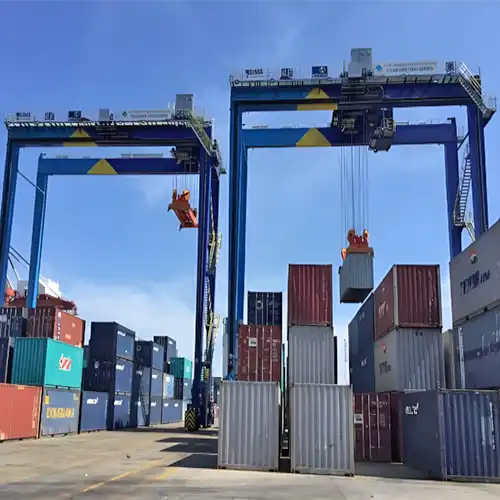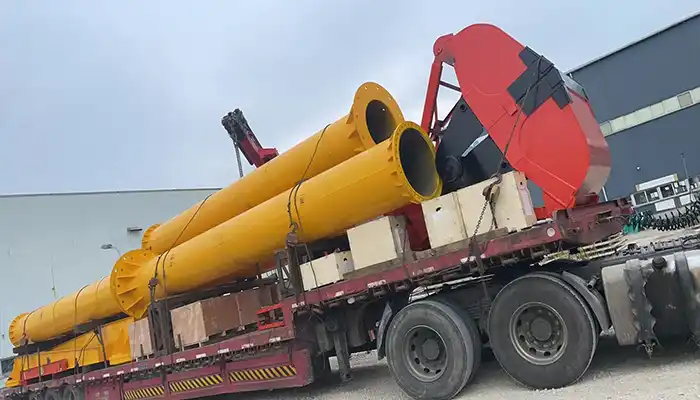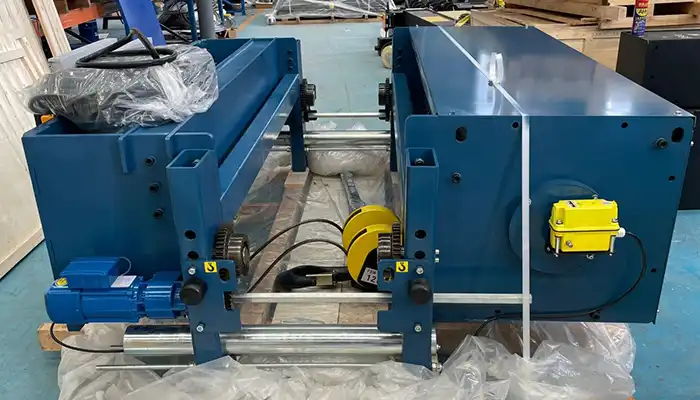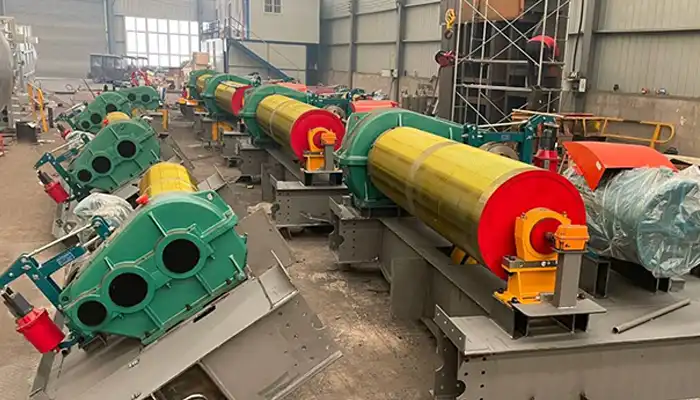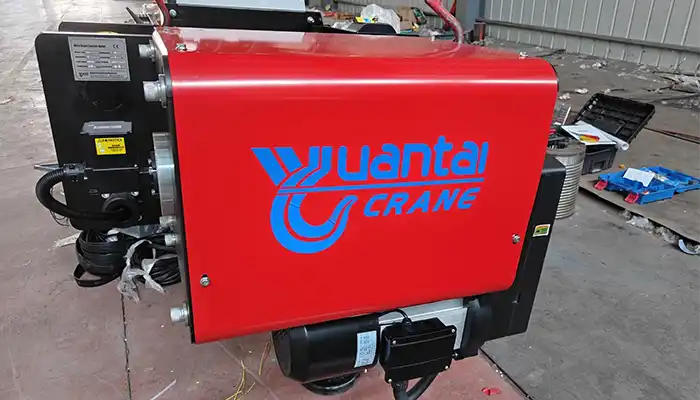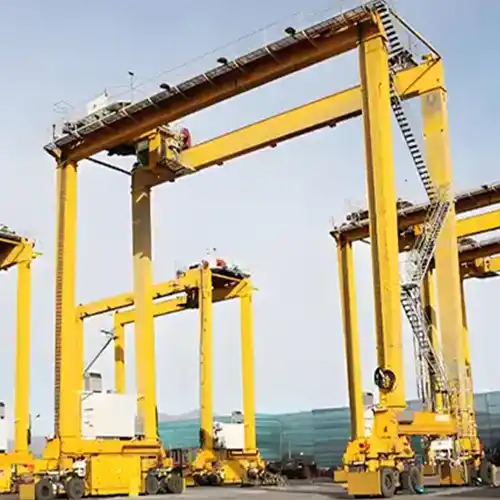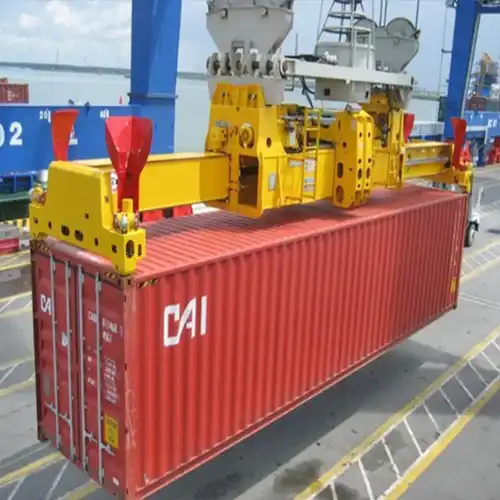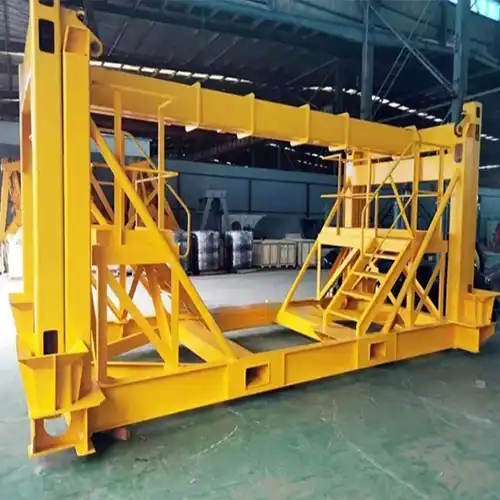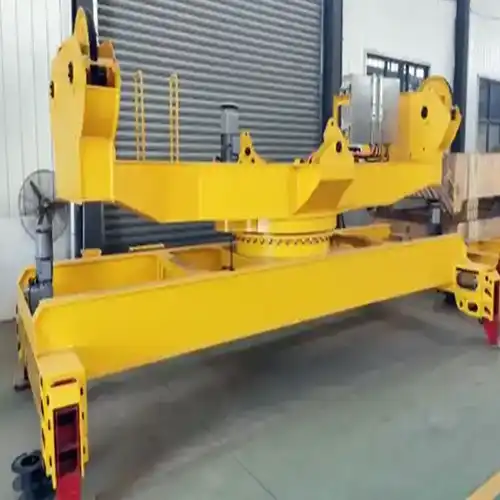RMG & RTG Container Gantry Cranes for ISO Container Handling
RMG & RTG designed for all ISO container handling. Container gantry cranes ensure precision, stability & efficiency in ports, terminals & logistics hubs.
Category: Featured
Your Trusted Container Crane Manufacturer & Supplier
Container Gantry Cranes for All Types of ISO Container Handling
Rail-Mounted Gantry (RMG) Cranes and Rubber-Tired Gantry (RTG) Cranes
Container gantry cranes are large machines used to lift, move, and stack ISO containers at ports and terminals. They are essential for speeding up the movement of containers from ships to storage areas or trucks, helping to keep goods flowing smoothly in the global supply chain. Without these cranes, ports would struggle to handle the huge volume of cargo, leading to delays and inefficiency.
These cranes are designed to handle all types of containers, including standard dry containers, refrigerated containers, and oversized ones. Their job is to quickly and safely move containers, keeping the port running smoothly and maximizing space.
Gantry cranes are crucial for handling various types of ISO containers in busy ports and container yards. These containers can vary from standard 20-foot and 40-foot sizes to more specialized ones, such as refrigerated (reefer) containers, open-top containers, and tank containers. Gantry cranes can be adjusted to handle different container types, thanks to their flexible spreader bars and powerful lifting capabilities.
By improving container stacking and movement, gantry cranes help optimize the use of space in container yards and reduce turnaround times for ships. This leads to faster unloading and loading, which is essential for handling the growing amount of global trade.
What Are Container Gantry Cranes?
Container gantry cranes are large, specialized cranes used to lift and move ISO containers at ports, terminals, and container yards. These cranes are essential for transferring containers between ships, trucks, and storage areas, making them a key part of efficient cargo handling.
How Container Gantry Cranes Work
These cranes are built to lift very heavy containers—sometimes over 40 tons—safely and accurately. They have a strong framework that allows them to operate over a container yard or dock, either on tracks or using rubber tires, depending on the type of crane. Their ability to move and stack containers quickly saves time, reduces labor costs, and maximizes space.
Main Parts of a Container Gantry Crane
- Gantry Structure: The main frame of the crane, including the legs and beams that support the lifting system.
- Hoisting System: The motorized winch or hoist that lifts and lowers containers.
- Spreader Bar: The horizontal bar that attaches to the hoist and grips the container. It adjusts to different container sizes.
- Control System: The system used to operate the crane, which includes both manual controls and automated features to ensure precise container handling.
Benefits for Ports and Terminals
Container gantry cranes, especially RMG and RTG types, offer several advantages to ports and container yards:
- Efficiency: Gantry cranes automate the container handling process, making it faster and reducing the time ships spend in port. This increases throughput and ensures that goods move quickly from ship to shore.
- Space Optimization: RMG cranes, with their ability to stack containers high, help make the most of available space. RTG cranes, with their flexibility, can cover larger areas and adjust to different container arrangements.
- Safety: Gantry cranes reduce the need for manual labor, which lowers the risk of accidents. Their precise operations also help ensure that containers are safely lifted and placed.
- Versatility: Both RMG and RTG cranes are capable of handling various types of containers, including heavy, oversized, or temperature-sensitive cargo. They can easily adapt to different container needs, from standard dry cargo to refrigerated or tank containers.
- Flexibility: RTG cranes, with their ability to move freely, are ideal for yards that need flexibility in container handling. On the other hand, RMG cranes provide greater precision and are perfect for smaller, high-traffic areas.
In summary, container gantry cranes play a vital role in keeping ports and container yards running smoothly. RMG and RTG cranes each have their own strengths: RMG cranes are great for efficient stacking in tight spaces, while RTG cranes offer flexibility in larger yards. Both types are essential for handling the wide range of ISO containers that come through ports, improving efficiency, safety, and space utilization. As ports continue to grow and container traffic increases, these cranes will remain key to the fast, safe, and efficient movement of goods worldwide.
Two Key Types of Gantry Cranes: RMG and RTG
Container gantry cranes are vital for port operations, helping to move and stack containers efficiently. The two primary types of these cranes are Rail-Mounted Gantry (RMG) Cranes and Rubber-Tired Gantry (RTG) Cranes. While both serve similar functions, they each excel in different environments depending on the operational needs of the terminal.
- RMG cranes are ideal for high-density, fixed-layout yards that need precision and space optimization.
- RTG cranes, on the other hand, are perfect for larger, flexible yards where mobility and quick repositioning are essential.
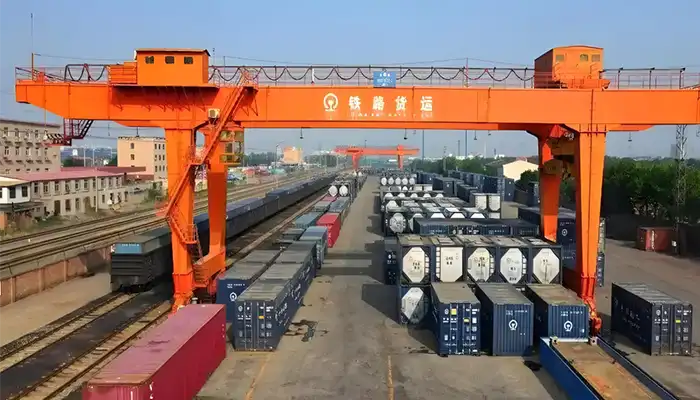
Rail-Mounted Gantry (RMG) Cranes
- How They Work: RMG cranes are fixed on rails, which means they move along a predefined track within the container yard. This design ensures that they stay within a specific area, providing precise and stable movement.
- Best For: RMG cranes are ideal for high-density container yards where space is limited, and precise stacking is crucial. Their fixed structure allows for efficient vertical stacking, making them perfect for terminals that require careful organization and optimized space usage.
Design and Structure Rail-Mounted Gantry (RMG) cranes are permanently installed on tracks or rails, allowing them to move smoothly and steadily across a set path. Their design is focused on stability, which helps them operate efficiently within the terminal.
- Structure: The crane's framework is rigid and robust, supporting large lifting capacities.
- Track System: RMG cranes rely on fixed rail infrastructure, which allows them to move containers with precision across a specific area.
Features
- Large Lift Capacities: RMG cranes are built to handle heavy containers, making them ideal for high-volume operations.
- High Precision: These cranes offer precise control over container placement, essential for stacking and retrieving containers in dense storage yards.
- Efficient Stacking: RMG cranes are designed for high-density stacking, optimizing space in container yards.
Applications RMG cranes are typically found in container yards and intermodal facilities where there is a need to move and stack large volumes of containers quickly and accurately.
- Container Terminals: Common in large container terminals, RMG cranes manage high-density stacking of containers.
- Heavy-Duty Stacking: These cranes are ideal for stacking standard and specialized containers, including refrigerated (reefer) containers, open-top containers, flat racks, and tank containers.
Handling ISO Containers RMG cranes can handle various ISO containers, including:
- 20-foot, 40-foot, 45-foot containers
- High-cube containers for oversized cargo
- Specialized containers like reefer containers (for temperature-sensitive goods), open-top containers (for over-height cargo), and tank containers (for liquids or hazardous materials).
Advantages
- Higher Operational Efficiency: RMG cranes provide fast and efficient handling of containers, improving turnaround time at busy terminals.
- Stable Stacking: Their precision allows for stable stacking, maximizing container storage capacity.
- Space Optimization: RMG cranes help reduce the need for large ground areas by stacking containers tightly and efficiently.
Limitations
- Fixed Infrastructure: RMG cranes require a fixed rail system, limiting their flexibility in terms of movement. They can only operate along the tracks, making them less adaptable in changing yard layouts.
- Slower Mobility: Compared to Rubber-Tired Gantry (RTG) cranes, RMG cranes have slower mobility as they are restricted to their rails.
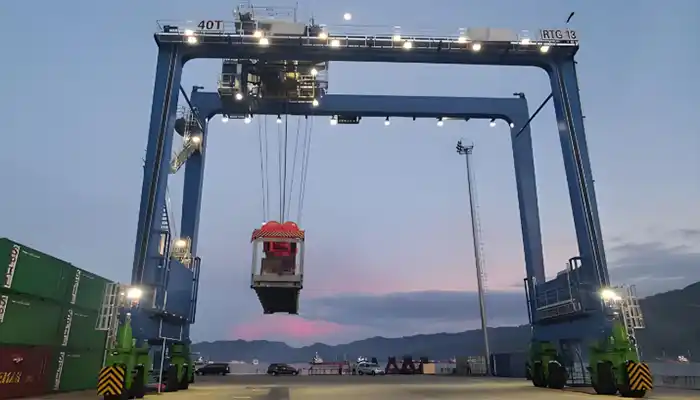
Rubber-Tired Gantry (RTG) Cranes
- How They Work: RTG cranes, in contrast, are mounted on rubber tires, giving them mobility. They can move freely across large, open yards, navigating in any direction without the restriction of fixed rails.
- Best For: RTG cranes are best suited for larger, more expansive container yards. They offer flexibility in operations, allowing cranes to travel easily between different container rows and adjust quickly to changing demands. They are perfect for environments where containers are stacked more loosely, and regular repositioning is required.
Design and Structure
RTG cranes are mounted on rubber tires, which give them the ability to move freely across container yards or terminals without the need for rails.
- Mobility and Flexibility: The rubber tires allow these cranes to navigate large areas and operate with high flexibility.
- Suitable for Expansive Areas: Ideal for large, open container yards, RTG cranes can handle a wide range of operations across different sections of the yard.
Applications
RTG cranes are commonly used in container terminals with a large operational footprint, especially where rail-mounted systems are impractical or space is limited.
- Large Container Yards: These cranes excel in environments where space is abundant and mobility is essential. They are ideal for yards that require high flexibility and can easily adapt to various layouts.
- High-Volume, Flexible Operations: RTGs are well-suited for operations that need the flexibility to move between different container rows and locations, making them perfect for busy terminals with mixed-container operations.
Handling ISO Containers
RTG cranes can handle virtually any type of ISO container, making them versatile in container terminals. They are capable of lifting and moving:
- Standard Containers: 20-foot and 40-foot containers are easily handled.
- Refrigerated (Reefer) Containers: RTGs can manage refrigerated containers that need temperature control during transit.
- High-Cube Containers: For larger, bulkier cargo, high-cube containers can also be efficiently moved.
- Oversized Containers: Flat racks and other oversized containers are no problem for RTG cranes.
Advantages
- High Mobility: The ability to move freely across large terminals gives RTG cranes an edge in flexible and dynamic environments. They are ideal for handling containers across wide areas, especially in mixed-container handling scenarios.
- Space Optimization: RTGs can be repositioned quickly between stacks, allowing for better space utilization and quicker turnaround times in container yards.
Limitations
- Lower Stacking Height: While RTG cranes are great for mobility, they generally offer lower stacking heights compared to Rail-Mounted Gantry (RMG) cranes. This can limit their ability to handle very dense container stacking.
- Maintenance Considerations: The weight of the tires and the wear from constant movement across the yard can lead to higher maintenance costs over time, especially compared to rail-mounted cranes.
In summary, RTG cranes are highly mobile, flexible, and well-suited for handling a wide variety of ISO containers in large container yards or terminals. They provide the ability to easily reposition between container rows, maximizing space utilization and making them an ideal choice for high-volume, dynamic operations. However, they may have limitations in stacking height and require more maintenance due to their mobile design.
Types of ISO Containers and Their Handling Requirements
ISO containers are built to accommodate a wide range of cargo types. Each container type has specific handling requirements that dictate the design and features of the container gantry cranes used for their efficient management. Container gantry cranes, including Rail-Mounted Gantry (RMG) and Rubber-Tired Gantry (RTG) cranes, are crucial in the logistics process, ensuring containers are moved safely and efficiently across terminal yards. Below is a detailed overview of the different types of ISO containers and their handling requirements.
Standard Containers (Dry Freight Containers)
Dimensions: 20', 40', 45'
Description:
Standard containers are the most commonly used and versatile type of container, designed to carry general cargo such as consumer goods, electronics, and packaged products. They are the backbone of international trade and available in various lengths and heights.
Handling Requirements:
- Handled using standard spreader bars attached to the container's corner castings.
- Gantry cranes should be equipped with adjustable hoisting systems to ensure safe and efficient lifting.
Typical Gantry Crane Design: - Spreader Bars: Fixed or adjustable to attach to the top corner castings of the container.
- Control Systems: Precise control systems are necessary for efficient stacking and positioning to maximize yard space utilization.
Typical Applications: - Container terminals, port facilities, and logistics hubs for handling general cargo.
- Efficient stacking and storage in intermodal facilities where containers are transferred between ships, trucks, and trains.
High Cube Containers
Dimensions: 40', 45' (height: 9'6")
Description:
These containers are taller than standard containers, offering extra volume for oversized or bulky items like furniture, electronics, and large industrial goods.
Handling Requirements:
- Gantry cranes must have adjustable lifting heights to accommodate the increased height.
- Special care is required to ensure stable lifting due to the container's added height and weight.
Typical Gantry Crane Design: - Height-adjustable Spreader Bars: To accommodate the taller containers, spreader bars need to be adjustable or telescoping.
- Extended Hoist Reach: Cranes should have the capability to extend the vertical hoist reach for safe and precise lifting.
Typical Applications: - High-volume port terminals, logistics centers, and warehouses dealing with large-scale and heavy cargo.
- Customized container yards where tall containers need to be stacked in high-density arrangements.
Refrigerated (Reefer) Containers
Features:
Refrigerated containers are equipped with an integral cooling system that requires an external power supply to maintain the temperature of sensitive cargo such as food, pharmaceuticals, or chemicals.
Handling Requirements:
- Electrical Connections are necessary on RMG and RTG cranes to supply power to the reefer container's cooling system during loading and unloading.
- Handling must be done with care to prevent disruption of the cooling system.
Typical Gantry Crane Design: - Power Supply Lines: Cranes should have electrical connectors to provide power to refrigerated units.
- Refrigeration Monitoring: Some cranes may incorporate temperature sensors to monitor the refrigeration system during handling.
Typical Applications: - Port terminals that handle perishable goods such as fruits, vegetables, pharmaceuticals, and frozen foods.
- Cold storage facilities and transportation hubs for managing temperature-sensitive cargo in global trade.
Open-Top Containers
Description:
Open-top containers lack a fixed roof and are typically used for goods that cannot be loaded through the standard doors, such as heavy machinery, large construction materials, or oversized industrial equipment.
Handling Requirements:
- Lifting Attachments: Cranes must be equipped with specific lifting attachments (e.g., hooks, spreaders) to securely lift cargo from the top.
- Special handling is required for heavy or irregularly shaped cargo, requiring cranes to have robust lifting capabilities.
Typical Gantry Crane Design: - Top Lifting Attachments: Specialized hooks or spreaders are required for lifting cargo from above.
- Increased Stability: Cranes should be designed with enhanced lifting stability to manage the irregular weight distribution of the load.
Typical Applications: - Heavy-lift operations in industrial yards, construction sites, and shipyards.
- Customized port facilities and logistics terminals specializing in oversized cargo or machinery.
Flat Rack Containers
Description:
Flat rack containers have no side walls but typically feature collapsible end walls or corner posts. They are ideal for carrying oversized or heavy cargo such as vehicles, large machinery, and construction equipment.
Handling Requirements:
- Requires lifting hooks or slings to secure the cargo during loading and unloading.
- The cargo is often bulky or irregularly shaped, necessitating careful handling and stable placement.
Typical Gantry Crane Design: - Lifting Slings and Hooks: Specially designed slings or hooks are used to lift the cargo securely from the flat rack.
- Extended Hoisting Mechanism: Cranes may need longer reach to accommodate bulky loads.
Typical Applications: - Oversized cargo handling at ports, shipyards, and warehouses that deal with heavy equipment or vehicles.
- Transportation hubs for specialized cargo transfer between ships, trucks, and rail.
Tank Containers
Description:
Tank containers are designed for transporting liquids, including hazardous chemicals, oils, food-grade liquids, or pharmaceuticals. These containers require specialized handling due to their liquid contents.
Handling Requirements:
- Specialized Slings or Hooks are required to prevent liquid surging during lifting.
- Cranes need to lift the container smoothly to avoid destabilizing the liquid cargo.
Typical Gantry Crane Design: - Liquid Stabilization Systems: Cranes may include additional dampers or stabilization features to minimize the risk of liquid surging during lifting.
- Specialized Slings and Hooks: Customized lifting devices are used for securing the container during handling.
Typical Applications: - Chemical plants, food-grade liquid transport, and pharmaceutical industries where precise handling of liquids is crucial.
- Port terminals dealing with hazardous material shipping and bulk liquid logistics centers.
Bulk Containers
Description:
Bulk containers are used for transporting loose materials like grains, cement, coal, and ores. They often include discharge systems to efficiently unload materials.
Handling Requirements:
- Gantry cranes must be integrated with customized discharge systems (e.g., pneumatic or hydraulic systems) for efficient unloading.
- Weight distribution systems are necessary to prevent spillage or damage to the contents.
Typical Gantry Crane Design: - Discharge Systems: Pneumatic or hopper systems allow for controlled and efficient unloading of bulk materials.
- Weight Distribution Systems: Cranes are designed to accommodate bulk containers while maintaining stability during the unloading process.
Typical Applications: - Bulk material handling at ports, warehouses, and mining operations.
- Common in grain terminals, cement facilities, and coal yards for handling large volumes of bulk materials.
Each ISO container type has specific handling requirements that are met by specialized container gantry cranes, such as RMG and RTG cranes. These cranes incorporate tailored lifting mechanisms, power supply systems, and discharge solutions to efficiently manage a wide range of containers, from standard dry freight containers to more complex, temperature-sensitive, or hazardous containers. By matching the appropriate crane design to each container type, ports, terminals, and intermodal facilities can ensure safe, efficient, and timely loading and unloading operations.
Handling Specialized Containers with Container Gantry Cranes
Handling specialized ISO containers requires container gantry cranes to be equipped with advanced features and adaptable systems. Whether dealing with reefer containers, high-cube containers, open-top containers, flat-rack containers, tank containers, or bulk containers, gantry cranes must offer tailored solutions to ensure efficient and safe handling. Rail-Mounted Gantry (RMG) cranes and Rubber-Tired Gantry (RTG) cranes are both designed with features to optimize the handling of these diverse, often challenging loads.
Handling Reefer (Refrigerated) Containers
RMG Cranes:
- Power Supply Units: Reefer containers carry temperature-sensitive cargo and require a continuous power supply to maintain their refrigeration units. RMG cranes are equipped with dedicated power supply units that connect directly to the reefer containers during the loading and unloading process, ensuring the cooling system remains operational.
- Precise Lifting: These cranes offer precise container handling capabilities to minimize disruption to the cold chain, ensuring perishable goods remain at the correct temperature and reducing the risk of spoilage during transit.
RTG Cranes:
- Mobility: RTG cranes offer the added benefit of mobility, enabling efficient management of reefer containers across large container yards or terminals. This flexibility ensures quick handling and efficient movement of refrigerated cargo.
- Power Outlets: RTG cranes are also equipped with power outlets that connect to the reefer containers, ensuring that the refrigeration units stay powered up throughout the lifting and transportation process.
Handling High-Cube Containers
RMG Cranes:
- Adjustable Lifting Heights: High-cube containers, which are taller than standard containers (9'6" high), require cranes with adjustable hoisting systems. RMG cranes feature these systems, allowing them to safely lift and stack taller containers.
- Optimized Stacking: By adjusting the crane's lifting height, RMG cranes can stack high-cube containers in higher tiers, helping to optimize space in the yard and increasing overall storage capacity.
RTG Cranes:
- Flexible Reach: RTG cranes provide extended reach or higher clearance, enabling them to accommodate the additional height of high-cube containers. This makes RTG cranes a versatile solution for handling taller containers, particularly in expansive terminals or yards.
- Efficiency: The flexibility of RTG cranes helps maximize space utilization in busy container yards, offering adaptable solutions for high-cube container storage and transport.
Handling Open-Top and Flat Rack Containers
Open-Top Containers:
- Lifting Attachments: Open-top containers, which are used to transport oversized or irregularly shaped cargo, require cranes with specialized lifting tools. RMG and RTG cranes are equipped with adjustable spreaders, clamps, and lifting slings that allow them to safely handle these types of containers.
- Versatile Handling: The cranes' ability to adjust lifting attachments ensures the safe and efficient transport of open-top containers, even with heavy or irregular cargo such as machinery or construction materials.
Flat-Rack Containers:
- Lifting Slings or Hooks: Flat rack containers are used for heavy or oversized cargo that cannot fit inside standard containers. RMG and RTG cranes utilize specialized slings or hooks to lift and secure flat racks, ensuring that large or irregularly shaped items are handled with care.
- Cargo Flexibility: The adaptability of these cranes ensures that they can handle flat racks with varying sizes and types of cargo, offering a secure and flexible solution for transporting non-standard loads.
Handling Tank and Bulk Containers
Tank Containers:
- Specialized Lifting Mechanisms: Tank containers, which carry liquids, gases, or hazardous materials, require special care to prevent spillage or imbalance during lifting. RMG and RTG cranes are equipped with custom lifting hooks and slings designed specifically for tank containers.
- Safety Features: These cranes are also fitted with stabilizing features to ensure the balanced lifting of tank containers, preventing liquid surging or accidents during transit.
Bulk Containers:
- Customized Discharge Systems: Bulk containers, which carry loose materials such as cement, grains, or ores, often require specialized discharge systems for unloading. RMG and RTG cranes are outfitted with customized systems like vibratory hoppers or grab buckets to unload bulk materials efficiently and safely.
- Adaptable Lifting Gear: Specialized lifting gears, such as slings and grabs, can be added to the cranes to handle bulk containers with different types of materials. These adaptable systems ensure the quick and secure unloading of dry bulk cargo without spillage.
RMG and RTG cranes are vital for managing specialized containers in modern container terminals. Their adaptability and specialized features, including adjustable lifting systems, custom lifting attachments, power supply units for reefer containers, and flexible handling capabilities, make them ideal for efficiently managing all types of ISO containers. From handling temperature-sensitive reefer containers to bulky flat racks, tank containers, and bulk cargo, these cranes provide the necessary tools to optimize space utilization, improve operational efficiency, and ensure safe container handling in a variety of terminal settings. Whether dealing with high-cube containers or hazardous tank containers, RMG and RTG cranes are designed to meet the diverse demands of modern container logistics
Key Features of RMG and RTG Cranes for ISO Container Handling
Rail-Mounted Gantry (RMG) and Rubber-Tired Gantry (RTG) cranes are essential for the efficient and safe handling of ISO containers in ports and container terminals. Both crane types share a number of key features that enhance their flexibility, productivity, and safety when handling various container types, from standard dry freight to specialized reefer and oversized containers. Below are the primary features that define RMG and RTG cranes.
Lifting Mechanisms
Spreader Bar:
- Functionality: The spreader bar is the primary tool used in ISO container handling. It attaches to the container's corner castings, enabling the crane to lift the container securely and efficiently.
- Adaptability: Spreader bars are designed to handle multiple container sizes, including 20', 40', and 45' containers. This flexibility allows for seamless handling of standard ISO containers, regardless of size.
- Use Cases: Suitable for general-purpose lifting operations, including dry freight containers, refrigerated (reefer) containers, and open-top containers.
Rotating Spreader:
- Functionality: A rotating spreader allows the crane to rotate the container during lifting, which is useful when containers are incorrectly loaded or need to be repositioned.
- Benefits: Enhances flexibility by allowing operators to place containers in precise positions, even if they need to be rotated during the lifting process.
- Use Cases: Ideal for situations where cargo requires rotation for correct placement, such as in busy container yards with a mix of container types and orientations.
Dual Lift Capability:
- Functionality: Dual lift cranes are equipped to lift two containers at once, maximizing lifting efficiency and reducing terminal congestion.
- Efficiency: This feature improves operational throughput in busy terminals, as it allows for the simultaneous handling of two containers, which reduces turnaround times and increases container movement capacity.
- Use Cases: Especially beneficial in high-traffic terminals, busy logistics hubs, and areas with high volumes of standard-sized containers.
Hoisting Systems
Electric Hoists:
- Precision: Electric hoists are the most commonly used lifting mechanism in both RMG and RTG cranes. These systems offer precise control for lifting and lowering containers, crucial for handling heavy or fragile cargo.
- Common Applications: Electric hoists are used to handle standard ISO containers, as well as temperature-sensitive reefer containers where precise control is required to maintain the integrity of the cargo.
- Benefits: The precision offered by electric hoists ensures safe handling, especially for delicate or perishable goods like pharmaceuticals or fresh produce.
Hydraulic Hoists:
- Functionality: Hydraulic hoists provide additional lifting power, which is beneficial for handling particularly heavy or oversized containers.
- Heavy Lifting: These hoists are suited for special applications, including lifting tank containers, bulk containers, or flat racks, which require higher lifting capacities.
- Use Cases: Suitable for applications where heavier cargo needs to be lifted safely, such as tank containers with liquid contents or bulky machinery in flat racks.
Power Supply for Reefer Containers
Reefer Container Power:
- Refrigerated Containers: Reefer containers require an external power source to maintain the cooling systems, which is essential for transporting perishable goods.
- Power Outlets: RMG and RTG cranes are equipped with power outlets that connect directly to the refrigeration units of reefer containers, ensuring the temperature is maintained during lifting and handling.
- Seamless Integration: The integration of power outlets ensures uninterrupted power supply to refrigerated containers, which prevents temperature fluctuations that could compromise the quality of sensitive cargo.
Enhanced Control Systems
Advanced Crane Controls:
- Functionality: Both RMG and RTG cranes feature sophisticated control systems that enable precise movement, lifting, and positioning of containers. These systems provide real-time feedback to operators, improving the overall safety and efficiency of operations.
- User-Friendly Interface: The crane's control systems are equipped with intuitive interfaces that simplify operation. Features like load monitoring, weight sensors, and clearance indicators ensure accurate handling and prevent accidents.
- Safety: Advanced control systems help prevent collisions, load imbalances, and other safety hazards in busy terminal environments.
Automated Systems:
- Automation Benefits: With increasing adoption of automation in port operations, many RMG and RTG cranes are now integrated with automated systems that allow for remote operation, predictive maintenance, and optimized scheduling.
- Efficiency: Automation helps reduce human error and improves operational efficiency by allowing cranes to operate autonomously or with minimal input from operators. This feature is especially valuable in terminals with high container volumes.
- Safety and Precision: Automated cranes can also optimize load distribution and avoid obstacles in the yard, enhancing safety and operational consistency.
RMG and RTG cranes are crucial for modern port and terminal operations, especially in managing the diverse range of ISO containers. Their advanced features—such as rotating spreaders, dual lift capability, adjustable hoisting systems, and integrated power supplies for refrigerated containers—ensure that these cranes can handle the complexities of containerized cargo efficiently and safely. The incorporation of automated systems further boosts operational performance, making these cranes indispensable for high-volume, high-efficiency container handling in global shipping hubs. Whether for standard containers, specialized reefer units, or oversized cargo, RMG and RTG cranes are designed to meet the demands of modern containerized logistics.
Advantages of RMG and RTG Cranes in Container Handling
Efficiency
Container gantry cranes, particularly Rail-Mounted Gantry (RMG) and Rubber-Tired Gantry (RTG) cranes, play a vital role in modern container terminals. These cranes offer distinct advantages that are crucial for enhancing port operations, improving throughput, and maximizing space utilization. Below are the key benefits that RMG and RTG cranes provide in container handling.
RMG Cranes:
- High-Speed Operations: RMG cranes are known for their ability to handle containers quickly, facilitating fast pickup and drop-off times. Their fixed rail structure allows for smooth, stable, and precise movements, reducing cycle times and increasing overall throughput.
- High Stacking Capacity: RMG cranes can stack containers higher, maximizing vertical space. This ability is particularly valuable in congested terminals where land area is limited, allowing operators to optimize yard space by building vertically rather than horizontally.
RTG Cranes:
- Mobility and Flexibility: RTG cranes are mounted on rubber tires, enabling them to move freely across large, sprawling terminal areas. This mobility allows them to handle large numbers of containers quickly, without being restricted to a fixed track.
- Quick Maneuvering: RTG cranes are well-suited for terminals that require frequent repositioning of cranes between stacks. Their agility allows for quick repositioning, optimizing the flow of containers across the terminal and improving operational efficiency.
Flexibility
RMG Cranes:
- Precision in Operations: RMG cranes are designed for environments that demand high precision. Their fixed-rail system ensures controlled, repeatable movements, making them ideal for tasks that require exact placement, such as in intermodal terminals or areas with dense container stacking.
- Structured Operations: RMG cranes excel in highly organized terminal operations. Their predictable and structured movements ensure that containers are stacked efficiently in high-density environments, making them particularly suited for terminals where maximizing vertical space is critical.
RTG Cranes:
- Mobility Across Large Areas: The key advantage of RTG cranes lies in their ability to move freely across expansive terminal yards. This mobility allows them to serve larger terminal areas or multiple container stacks, providing greater operational flexibility in less structured or more widely spaced environments.
- Adaptability to Various Cargo: Because RTG cranes can travel between various areas of a terminal, they are ideal for terminals that require constant repositioning, whether for containers of different sizes or types of cargo that need to be handled at multiple locations.
Space Optimization
RMG Cranes:
- Compact Yard Utilization: The fixed-rail system and high stacking capabilities of RMG cranes make them perfect for densely packed terminals. By stacking containers higher, RMG cranes optimize vertical space and increase storage capacity, especially valuable in urban ports or terminals with limited available land.
- Maximized Storage: The ability to stack containers vertically reduces the horizontal spread of containers, allowing for more cargo to be stored within a given yard area. This compact utilization is ideal for terminals where expanding outward is not an option.
RTG Cranes:
- Wide Area Coverage: RTG cranes are highly flexible and can cover expansive areas of a terminal without the need for fixed infrastructure like rails. This makes them especially effective for terminals with wide yards that require cranes to service multiple rows or areas.
- Adaptability to Layouts: Since RTG cranes are not constrained by tracks, they can adapt to the unique shape and size of a terminal, making them perfect for irregular or large terminal configurations. This flexibility ensures that RTG cranes can efficiently handle containers in sprawling, less structured environments.
RMG and RTG cranes provide complementary advantages in container handling, each suited to different operational needs. RMG cranes excel in high-density areas that require precision, stability, and high stacking capabilities, making them perfect for terminals with limited space. On the other hand, RTG cranes offer superior flexibility and mobility, making them ideal for large, expansive terminal operations or those requiring frequent repositioning of cranes.
By strategically integrating both types of cranes into terminal operations, ports can maximize both efficiency and space utilization, ultimately improving overall container throughput and optimizing yard management. Whether focused on precision and vertical space or agility across wide yards, RMG and RTG cranes are essential to meeting the diverse demands of modern container logistics.
Safety Considerations for RMG and RTG Cranes
Preventive Safety Measures
Safety is a paramount concern in container handling operations, especially when dealing with large and heavy ISO containers. Both Rail-Mounted Gantry (RMG) cranes and Rubber-Tired Gantry (RTG) cranes are designed with a range of safety features to ensure the protection of personnel, equipment, and the cargo being handled. Below are some of the key safety considerations for these cranes.
Regular Inspections:
Routine inspections are essential for ensuring the safe operation of both RMG and RTG cranes. Key crane components, such as spreader bars, hoists, and tires (for RTGs), must be thoroughly checked for wear and tear. Regular inspection helps identify potential issues before they escalate into safety hazards.
- For RTGs, specific attention should be paid to the tires and wheels, as they are subject to wear due to frequent movement across the terminal.
- For RMGs, inspection of the rails and track systems is critical to prevent issues like derailment or misalignment.
Safety Sensors and Cameras:
To prevent accidents and ensure the safe loading/unloading of containers, safety sensors and cameras are installed on both RMG and RTG cranes. These devices help operators detect obstacles in the crane's path, reducing the risk of accidental collisions with personnel, equipment, or containers.
- Proximity sensors can help ensure that operators are aware of nearby objects when the crane is moving, while cameras give real-time visual feedback to enhance situational awareness.
- Collision avoidance systems are increasingly being integrated to automatically stop the crane if an obstruction is detected.
Automated and Remote-Control Features
Automation for Safety:
Automation in RMG and RTG cranes not only boosts efficiency but also enhances operational safety. By reducing the amount of manual intervention, automated systems minimize the chances of human error during crane operation.
- Automated Guided Vehicles (AGVs) and automated systems allow for more precise movements, reducing the likelihood of accidents caused by misjudgment or operator fatigue.
- In some advanced systems, automated stacking allows cranes to position containers with a high degree of accuracy without human involvement, ensuring that stacking is done safely and securely.
Remote-Control Operation
Remote control allows operators to control the crane from a safe distance, further enhancing safety. This can be especially useful in dangerous situations, such as severe weather or hazardous cargo handling. By using remote control, operators can maintain visibility and avoid direct exposure to dangerous environments.
- Remote monitoring systems are also available, where supervisors can keep track of crane operations in real-time, ensuring all safety protocols are being followed.
Load Monitoring Systems
Real-time Load Monitoring:
To ensure that containers are handled within their safe weight limits, both RMG and RTG cranes are often equipped with real-time load monitoring systems. These systems use weight sensors to track the weight of the container being lifted, providing constant feedback to the operator.
- Overload protection is crucial in preventing accidents caused by lifting containers that exceed the crane's rated capacity. If a container is too heavy, the system will alert the operator, preventing the crane from lifting an unsafe load.
- Load sway control systems are also commonly integrated into crane operations to reduce the swinging of containers during lifting, further enhancing safety during handling.
Weight Sensors
These load sensors ensure that the weight of the container is within the allowable limits for safe operation. They can be integrated with the crane's control system to automatically adjust lifting speeds and operations based on the load, preventing strain on the crane's hoisting system.
RMG and RTG cranes are equipped with numerous safety features designed to protect both operators and cargo. By incorporating preventive safety measures, such as regular inspections and safety sensors, and by utilizing automated and remote-control systems, these cranes offer a safer working environment. Additionally, load monitoring systems ensure that containers are lifted safely within their weight limits, minimizing the risk of accidents and enhancing the overall safety of container handling operations.
Maintenance and Operational Considerations
RMG Cranes: Rail and Structural Maintenance
Maintaining RMG (Rail-Mounted Gantry) and RTG (Rubber-Tired Gantry) cranes is crucial for ensuring their reliable performance, safety, and longevity in container handling operations. Regular maintenance activities help reduce downtime, improve operational efficiency, and prevent costly repairs. Below is an overview of the maintenance and operational considerations specific to each type of crane.
Rail Maintenance:
Since RMG cranes are mounted on rails, it is vital to maintain the rail infrastructure in optimal condition. Regular inspections should be conducted to check for any signs of wear or misalignment in the rails and track system. Proper rail alignment is necessary to ensure smooth and efficient crane movement.
- Track wear due to frequent movement and weight-bearing needs to be closely monitored. If the rails are not well-maintained, it can cause jerky crane motions and increased wear on the crane's wheel system.
Hoist and Lifting Mechanism Maintenance:
The hoisting system and lifting mechanisms (such as the spreader bars) are among the most critical components of an RMG crane. Routine checks must be performed to ensure these systems are functioning correctly. Maintenance tasks include:
- Inspection of hoist cables for wear or fraying.
- Regular lubrication of hoisting motors and gears to maintain smooth operation.
- Checking the spreader bar for any signs of damage or wear, particularly where it makes contact with containers.
RTG Cranes: Tire and Mobility Maintenance
Tire and Mobility System Maintenance:
For RTG cranes, which rely on rubber tires for mobility, it's crucial to maintain the tire system to ensure safe and efficient crane movement across the terminal. Regular tire inspections are necessary to look for:
- Uneven wear or tire damage, which can affect crane stability and efficiency.
- Proper tire inflation to ensure optimal load-bearing capacity and mobility.
- Monitoring for misalignment in the wheel system to prevent excessive wear and tear.
Electrical Systems and Reefer Connections:
RTG cranes often work with reefer containers, which require a reliable power supply for refrigeration. Routine maintenance should include:
- Checking electrical connections for reefer containers to ensure they are providing adequate power for refrigeration.
- Inspecting power cables and electrical components to prevent any power supply interruptions during loading/unloading operations.
Preventive Maintenance for Both RMG and RTG Cranes
Timely Component Replacement:
Both RMG and RTG cranes feature components that endure constant stress and usage, so it is essential to replace worn-out parts on time to maintain crane functionality. This includes:
- Tires (RTG): Tires are subject to heavy wear due to the crane's mobility, so timely replacement is essential to maintain safe operations.
- Rails (RMG): Rails experience wear over time due to the weight and movement of the crane, which can result in misalignment or damage.
- Hoist components: Cables, pulleys, and lifting mechanisms should be regularly replaced to prevent operational failure.
Calibration of Control Systems and Hoists:
Regular calibration of control systems and hoists is critical for ensuring precise and accurate container handling. The control systems should be recalibrated to ensure that all crane movements, including lifting and positioning, are done with optimal precision. Calibration also helps in:
- Ensuring smooth lifting and lowering operations without jerky movements.
- Preventing overloading situations by accurately monitoring the crane's lifting capacity and limits.
Both RMG and RTG cranes require consistent and thorough maintenance to ensure optimal performance in container handling operations. RMG cranes need careful attention to rail infrastructure and hoisting mechanisms, while RTG cranes require regular maintenance of tires, mobility systems, and reefer connections. Preventive maintenance, including timely replacement of worn components and regular calibration of control systems, is key to extending the life of these cranes and maintaining a safe and efficient terminal operation.
Conclusion
Container gantry cranes, specifically Rail-Mounted Gantry (RMG) and Rubber-Tired Gantry (RTG) cranes, play a crucial role in modern port and terminal operations. They are essential for efficiently handling a wide range of ISO containers, from standard dry freight containers to specialized types such as reefer, high-cube, and open-top containers. Both types of cranes come with distinct advantages and features that make them ideal for different terminal environments.
Summary of Benefits and Unique Features
- RMG Cranes offer high precision and efficiency, with the ability to stack containers higher and optimize yard space. Their fixed rail structure makes them excellent for high-density stacking in terminal yards where space utilization is key.
- RTG Cranes, on the other hand, provide mobility and flexibility. Mounted on rubber tires, they can move easily across large, spread-out terminals, making them suitable for high-volume operations in spaces that require greater maneuverability and adaptability.
- Both crane types are designed to handle various types of ISO containers, providing versatility in lifting and moving containers of different sizes, weights, and special handling requirements such as temperature-controlled or oversized cargo.
Choosing the Right Crane for Specific Needs
The choice between RMG and RTG cranes depends largely on the terminal's specific needs:
- Space considerations: For terminals with limited space, RMG cranes are ideal due to their ability to stack containers vertically and optimize yard space. Conversely, if flexibility and large operational areas are more important, RTG cranes offer the mobility required for handling containers across expansive yard spaces.
- Flexibility and mobility: RTG cranes are more adaptable for terminals that need frequent repositioning of cranes across multiple container rows or in diverse areas. RMG cranes are better suited for operations with fixed layouts and more structured handling requirements.
- Load capacity: Both crane types can handle various container sizes, but the decision should also take into account the maximum load requirements, stack height needs, and container types being handled. RMG cranes excel at high stacking for heavy-duty operations, while RTG cranes can handle a wider variety of containers more flexibly.
In conclusion, choosing the right crane for container handling depends on the terminal's operational requirements. RMG cranes are well-suited for fixed, high-density operations, while RTG cranes offer unmatched flexibility for larger, more spread-out terminals. With advancements in automation, sustainability, and smart technology, both crane types are evolving to meet the demands of modern container logistics, making them crucial assets for efficient and effective port operations.
Main Projects
Related Products
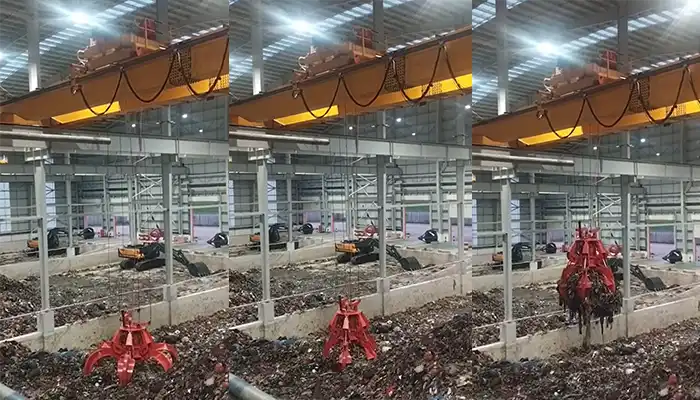
Supplied three grab bucket crane kits to Indonesia, enhancing garbage handling efficiency with high load capacity and reliable performance.
Free consultation to Confirm Parameters & Specifications and Get
Latest Crane Price & Crane Rate.
- Types of overhead cranes : _______?
- Optional: Overhead travelling crane, goliath gantry crane,Slewing jib crane, Single girder or double girder crane,small portable crane or kbk crane, etc.
- Capacity of overhead crane: _______?
- Optional: 0.25ton, 0.5 ton, 1 ton, 2 ton, 3ton, 5 ton, 10 ton,15ton, 20ton, 25 ton, 30ton,35ton, up to 550ton, etc.
- Crane span & lifting height : _______?
- Crane travelling length : _____?
- Control of overhead crane:_______?
- Optional: pendant/ remote/cabin control
- Voltage supply of overhead crane:_____?
- Eg,: 380V50/60HZ,3Phase or others,etc.
- Application/usage of crane:_______?
- Eg,: Steel mill, ,injection mold, cement,stone, concrete,granite, general manufacturing, etc.
Just leave a message via the contact form and our hoist and crane engineer will contact you with in 24working hours.
Get In Touch
